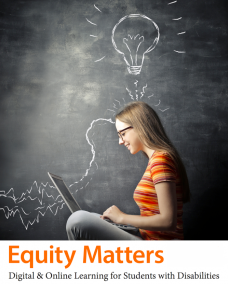How to help students make real world connections using digital learning
Many of today’s veteran teachers are a part of the generations that grew up without smartphones or Wi-Fi. We learned in classrooms where the overhead projector was cutting-edge technology.
5 things you don't know about K-12 virtual learning
Online learning has come a long way since its early champions saw it as a supplement to classroom learning.
Personalized education comes with pain - and gain
We’ve all heard the saying, “It’s a marathon, not a sprint,” but recent research by the Institute for Teaching and Leading into educational programs across the country demonstrates that this saying may be even more true than we think when it comes to the digital learning landscape.
Office of Civil Rights: Ensuring equitable access to online learning
As online learning and digital applications expand into almost every aspect of a student’s education and as fully online, blended, and supplemental online course programs continue to expand, state departments and school districts must consider how implementation of this wide range of digital options impacts equity in educational opportunities for families and students with disabilities.
Release of the revised K-12 National Standards for Quality Online Teaching and Programs
In an effort led by Quality Matters (QM) and the Virtual Learning Leadership Alliance (VLLA), the National Standards for Quality Online Programs and National Standards for Quality Online Teaching were released earlier this week.
Addressing parental concerns about the virtual classroom
As virtual education continues to grow, more parents are faced with the decision of whether or not to enroll their child in an online course.
Six strategic steps to digital learning success
Shiny new technologies can capture well-meaning educators like insects in amber, but the evidence is clear that digital learning can improve student opportunities and outcomes. The key is building the basic foundation of understanding and planning.
MOOCs never amounted to much
If you’re not familiar with the Gartner hype cycle, you should be, because it provides a useful framework for thinking about the excitement/puff/hysteria that seems to accompany so much technology in education. The cycle diagram shows expectations rapidly rising after a new innovation is introduced, followed by an equally fast fall into the “trough of disillusionment.”
Digging deeper into the i3 Grant evaluation
Honestly, both my conversation with and subsequent column in The Hechinger Report may have focused more on the difficulty of research and educational innovation, and not enough on the importance of building an evidence base. Evidence is the only way to determine which innovations are promising and effective, and integrating evidence helps prevent practitioners from implementing ineffective ideas, like the 1 development project found to have statistically negative effects in the i3 evaluation.
Teacher commitment to education technology is necessary
Introducing technology into the classroom requires accommodating changes to a school’s curriculum. When technology is implemented it represents a shift away from traditional methods of teaching; we must realize that not all teachers have the facility to commit, engage, and leverage technology effectively.
This may be due to a lack of belief in education technology, or it may be as simple as a lack of opportunity to develop the necessary skills and conceptualize its benefits. Teachers are not always comfortable with technology in the classroom, but there needs to be an affective commitment in order for technology to be effective in their classroom. According to “Acquiring Teacher Commitment to 1:1 Initiatives: The Role of the Technology Facilitator,” in the Journal of Research on Technology in Education, affective commitment in terms of technology integration is evident in three ways:
5 myths to bust about blended learning, what it is, and the benefits it has for students
Over the past several years, more and more schools across the U.S. have been implementing blended-learning strategies for their students. What is blended learning? … This isn’t an exhaustive picture of K-12 blended implementations across the world. But it provides a framework for busting some common myths about what blended learning is, and isn’t.
Are we too quick to judge innovation grant findings?
A recent column from The Hechinger Report shared findings from U.S. Department of Education’s innovation grants and what Hechinger calls “the ‘dirty secret.’” These grants were created to boost the economy after the 2008 recession and served as a “first test of using rigorous scientific evidence as a way of issuing grants in education.” Those programs that had a concept that was well-proven were issued $25-50 million while programs who did not have an evidence-based concept were given $5 million or less to help build that base. Unfortunately, the results show that only 18%, or 12 out of 67, innovations have shown an increase in student achievement.
The research-to-practice gap in education is especially important to digital instruction
Many educators and most researchers know that there’s a gap between research and practice in K-12 education. This gap is especially important regarding online courses, tools, and resources, because digital instructional practices are new and often considered to be unproven.
But relatively few people seem to understand the extent of the gap, why it is important, and what to do about it.












